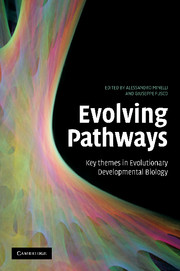Book contents
- Frontmatter
- Contents
- Contributors
- Preface
- Introduction: Pathways of change
- Part I Thinking about evolution by taking development on board
- Part II Evo-devo: methods and materials
- 7 A pragmatic approach for selecting evo-devo model species in amniotes
- 8 On comparisons and causes in evolutionary developmental biology
- 9 Evolution and development: towards a synthesis of macro- and micro-evolution with ecology
- 10 When is a Hox gene not a Hox gene? The importance of gene nomenclature
- 11 Plants are used to having identity crises
- Part III Evolving diversity
- Part IV Evolving body features
- Index
- References
10 - When is a Hox gene not a Hox gene? The importance of gene nomenclature
Published online by Cambridge University Press: 08 August 2009
- Frontmatter
- Contents
- Contributors
- Preface
- Introduction: Pathways of change
- Part I Thinking about evolution by taking development on board
- Part II Evo-devo: methods and materials
- 7 A pragmatic approach for selecting evo-devo model species in amniotes
- 8 On comparisons and causes in evolutionary developmental biology
- 9 Evolution and development: towards a synthesis of macro- and micro-evolution with ecology
- 10 When is a Hox gene not a Hox gene? The importance of gene nomenclature
- 11 Plants are used to having identity crises
- Part III Evolving diversity
- Part IV Evolving body features
- Index
- References
Summary
GENE CLASSIFICATION IS AN ESSENTIAL PRECURSOR TO EVO-DEVO
A sensible classification of developmental control genes and an understanding of their phylogeny are essential to any endeavour of molecular evolutionary developmental biology (evo-devo) or comparative genomics, since it is crucial that the structure, expression and function of orthologous genes are being compared between taxa. This is particularly true for the homeobox genes, for which there are confusing and conflicting names and classifications that hinder our investigation and understanding of their evolution and their role in animal evo-devo (I will restrict myself here to consideration of animal homeobox genes). Since these genes are central components of most developmental processes, are important indicators of major transitions in animal genome evolution, and are often found to be targets and/or agents of the evolution of development, then we must continue to improve and coordinate our classifications of these genes as more data become available from a greater array of taxa in this age of genomics.
CONVENTIONS
Animal homeobox genes can be divided, on the basis of their sequence similarities, into two major classes (ANTP and PRD) along with several minor classes (TALE, LIM, POU, ZF, cut, prox, HNF and SIX; Bürglin 2005, Edvardsen et al. 2005, Holland and Takahashi 2005). It is in the ANTP-class that most confusion and discrepancy exists, and so I shall concentrate on this class and attempt to resolve at least some of the confusion.
- Type
- Chapter
- Information
- Evolving PathwaysKey Themes in Evolutionary Developmental Biology, pp. 175 - 193Publisher: Cambridge University PressPrint publication year: 2008
References
- 4
- Cited by



